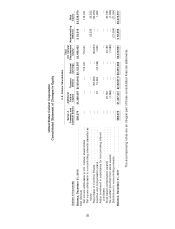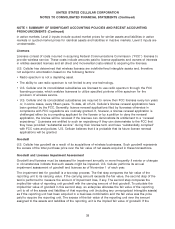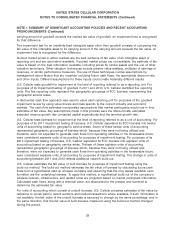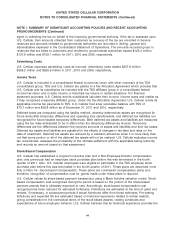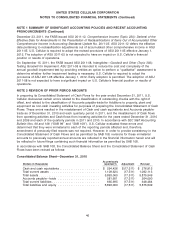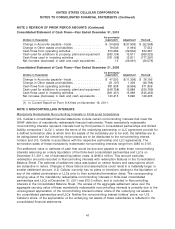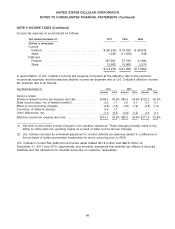US Cellular 2011 Annual Report Download - page 50
Download and view the complete annual report
Please find page 50 of the 2011 US Cellular annual report below. You can navigate through the pages in the report by either clicking on the pages listed below, or by using the keyword search tool below to find specific information within the annual report.UNITED STATES CELLULAR CORPORATION
NOTES TO CONSOLIDATED FINANCIAL STATEMENTS (Continued)
NOTE 1 SUMMARY OF SIGNIFICANT ACCOUNTING POLICIES AND RECENT ACCOUNTING
PRONOUNCEMENTS (Continued)
Revenue Recognition
Revenues from wireless operations consist primarily of:
• Charges for access, airtime, roaming, long distance, data and other value added services provided to
U.S. Cellular’s retail customers and to end users through third-party resellers;
• Charges to carriers whose customers use U.S. Cellular’s systems when roaming;
• Sales of equipment and accessories;
• Amounts received from the Universal Service Fund (‘‘USF’’) in states where U.S. Cellular has been
designated an Eligible Telecommunications Carrier (‘‘ETC’’); and
• Redemptions of loyalty reward points for products or services.
Revenues related to wireless services and other value added services are recognized as services are
rendered. Revenues billed in advance or in arrears of the services being provided are estimated and
deferred or accrued, as appropriate.
Revenues from sales of equipment and accessories are recognized when title and risk of loss passes to
the agent or end-user customer.
In October 2009, the FASB issued Accounting Standards Update No. 2009-13, Multiple Deliverable
Revenue Arrangements—a consensus of FASB Emerging Issues Task Force (‘‘ASU 2009-13’’). ASU
2009-13 provides for less restrictive separation criteria that must be met for a deliverable to be
considered a separate unit of accounting. Additionally, under this Standard, there is a hierarchy for
determining the selling price of a unit of accounting and consideration must be allocated using a relative-
selling price method. U.S. Cellular was required to adopt the provisions of ASU 2009-13 on January 1,
2011, however elected to adopt the provisions as of October 1, 2010 on a retroactive basis to January 1,
2010. The adoption of ASU 2009-13 on October 1, 2010 had no impact on any previously reported
financial statement amounts for 2010 interim periods.
U.S. Cellular allocates revenue to each element of these service offerings accounted for under ASU
2009-13 using the relative selling price method. Under this method, arrangement consideration, which
consists of the amounts billed to the customer net of any cash-based discounts, are allocated to each
element on the basis of their relative selling price, on a stand-alone basis. Such stand-alone selling price
is determined in accordance with the following hierarchy:
• U.S. Cellular-specific objective evidence of stand-alone selling price, if available; otherwise
• Third-party evidence of selling price, if it is determinable; otherwise
• A best estimate of stand-alone selling price.
U.S. Cellular estimates stand-alone selling prices of the elements of its service offerings as follows:
• Wireless services—Based on the actual selling price U.S. Cellular offers when such plan is sold on a
stand-alone basis, or if the plan is not sold on a stand-alone basis, U.S. Cellular’s estimate of the price
of such plan based on similar plans that are sold on a stand-alone basis.
• Wireless devices—Based on the selling price of the respective wireless device when it is sold on a
stand-alone basis.
• Phone Replacement—Based on U.S. Cellular’s estimate of the price of this service if it were sold on a
stand-alone basis, which was calculated by estimating the cost of this program plus a reasonable
margin.
42





